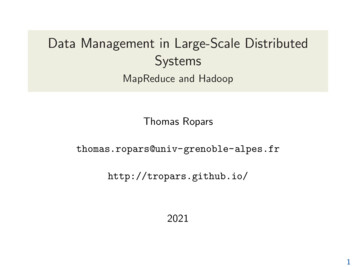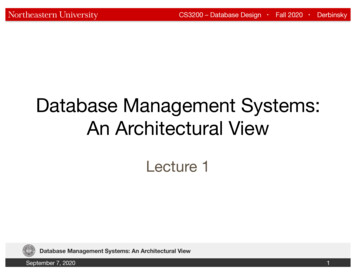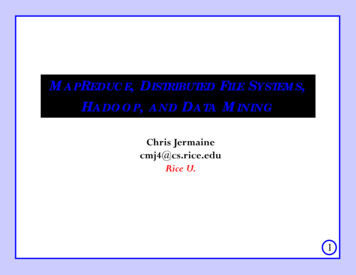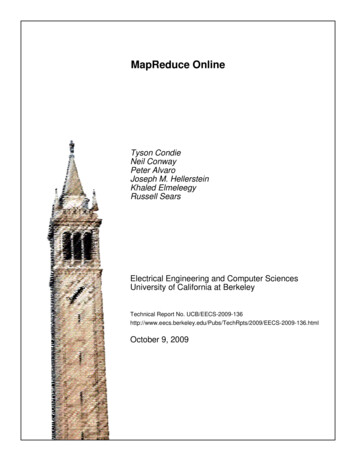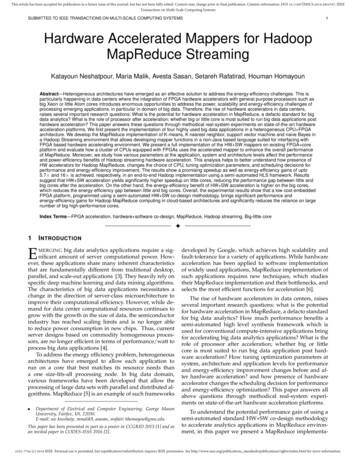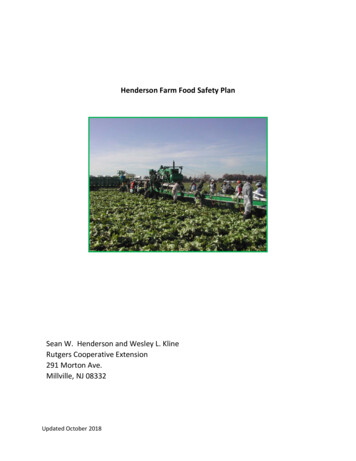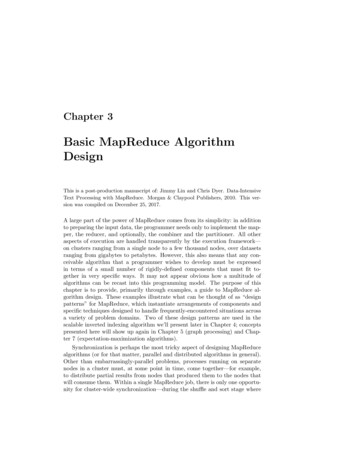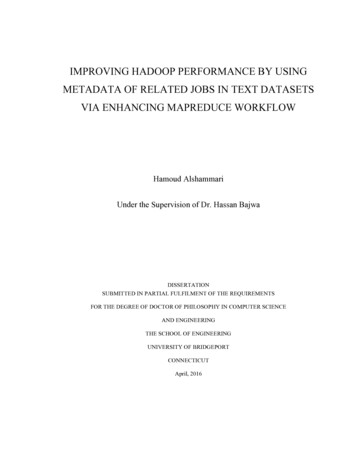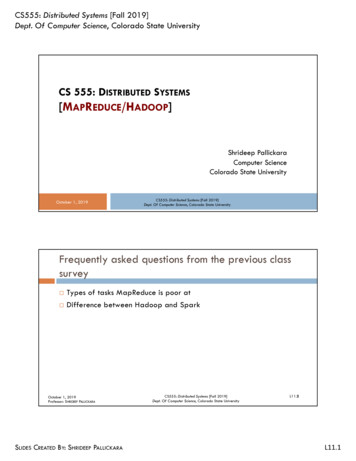
Transcription
CS555: Distributed Systems [Fall 2019]Dept. Of Computer Science, Colorado State UniversityCS 555: DISTRIBUTED SYSTEMS[MAPREDUCE/HADOOP]Shrideep PallickaraComputer ScienceColorado State UniversityOctober 1, 2019CS555: Distributed Systems [Fall 2019]Dept. Of Computer Science, Colorado State UniversityFrequently asked questions from the previous classsurvey Types of tasks MapReduce is poor at Difference between Hadoop and SparkOctober 1, 2019Professor: SHRIDEEP PALLICKARASLIDES CREATED BY: SHRIDEEP PALLICKARACS555: Distributed Systems [Fall 2019]Dept. Of Computer Science, Colorado State UniversityL11.2L11.1
CS555: Distributed Systems [Fall 2019]Dept. Of Computer Science, Colorado State UniversityTopics covered in this lecture HadoopPhases of Map Phases of Reduce Examples CS555: Distributed Systems [Fall 2019]Dept. Of Computer Science, Colorado State UniversityOctober 1, 2019Professor: SHRIDEEP PALLICKARAL11.3HADOOPOctober 1, 2019SLIDES CREATED BY: SHRIDEEP PALLICKARACS555: Distributed Systems [Fall 2019]Dept. Of Computer Science, Colorado State UniversityL11.2
CS555: Distributed Systems [Fall 2019]Dept. Of Computer Science, Colorado State UniversityHadoop Java-based open-source implementation of MapReduce Created by Doug Cutting Origins of the name Hadoop Stuffed yellow elephantIncludes HDFS [Hadoop Distributed File System]L11.5CS555: Distributed Systems [Fall 2019]Dept. Of Computer Science, Colorado State UniversityOctober 1, 2019Professor: SHRIDEEP PALLICKARAHadoop: MapReduce DataflowInput HDFSSortsplit 0MapCopyOutput HDFSMergeReducesplit 1Part 0HDFSReplicationMapMergeReducesplit 2HDFSReplicationMapOctober 1, 2019Professor: SHRIDEEP PALLICKARASLIDES CREATED BY: SHRIDEEP PALLICKARAPart 1CS555: Distributed Systems [Fall 2019]Dept. Of Computer Science, Colorado State UniversityL11.6L11.3
CS555: Distributed Systems [Fall 2019]Dept. Of Computer Science, Colorado State UniversityIn Hadoop a Map task has 4 phases Record reader MapperCombiner PartitionerOctober 1, 2019Professor: SHRIDEEP PALLICKARACS555: Distributed Systems [Fall 2019]Dept. Of Computer Science, Colorado State UniversityL11.7Map task phases: Record Reader Translates input splits into records Parse data into records, but does not parse the record itself Passes the data to the mapper in the form of a key/value pairkey in this context is positional information value is the chunk of data that comprises a record October 1, 2019Professor: SHRIDEEP PALLICKARASLIDES CREATED BY: SHRIDEEP PALLICKARACS555: Distributed Systems [Fall 2019]Dept. Of Computer Science, Colorado State UniversityL11.8L11.4
CS555: Distributed Systems [Fall 2019]Dept. Of Computer Science, Colorado State UniversityMap task phases: Map User-provided code is executed on each key/value pair from therecord reader This user-code produces zero or more new key/value pairs, called theintermediate pairskey is what the data will be grouped on and value is the informationpertinent to the analysis in the reducer Choice of key/value pairs is critical and not arbitrary October 1, 2019Professor: SHRIDEEP PALLICKARACS555: Distributed Systems [Fall 2019]Dept. Of Computer Science, Colorado State UniversityL11.9Map task phases: Combiner Can group data in the map phase Takes the intermediate keys from the mapper and applies a userprovided method to aggregate values in the small scope of that onemapper Significantly reduces the amount of data that has to move over thenetwork. Sending (“hello”, 3) requires fewer bytes than sending (“hello”, 1) threetimes over the networkOctober 1, 2019Professor: SHRIDEEP PALLICKARASLIDES CREATED BY: SHRIDEEP PALLICKARACS555: Distributed Systems [Fall 2019]Dept. Of Computer Science, Colorado State UniversityL11.10L11.5
CS555: Distributed Systems [Fall 2019]Dept. Of Computer Science, Colorado State UniversityCombiner function No guarantees on how many times Hadoop will call this on a map outputrecord The combiner should, however, result in the same output from the reducerCombiners must be commutative and associative Sometimes they are also called distributiveCommutative: Order of operands (5 2) 2 5n Division and subtraction are not commutativeAssociative: Order of operators 5 x (5x3) (5x5)x3Non-associative and non-commutative: Vector cross products and matrixmultiplication (AB BA) respectivelyOctober 1, 2019Professor: SHRIDEEP PALLICKARACS555: Distributed Systems [Fall 2019]Dept. Of Computer Science, Colorado State UniversityL11.11Map task phases: Partitioner Takes the intermediate key/value pairs from the mapper (or combiner)and splits them up into shards, one shard per reducer Default: key.hashCode() % (number of reducers)Randomly distributes the keyspace evenly over the reducers But still ensures that keys with the same value in different mappers end up atthe same reducer October 1, 2019Professor: SHRIDEEP PALLICKARASLIDES CREATED BY: SHRIDEEP PALLICKARACS555: Distributed Systems [Fall 2019]Dept. Of Computer Science, Colorado State UniversityL11.12L11.6
CS555: Distributed Systems [Fall 2019]Dept. Of Computer Science, Colorado State UniversityMap task phases: Partitioner Partitioner can be customized (e.g. for sorting) Changing the partitioner is rarely necessaryThe partitioned data is written to the local file system for each mapand waits to be pulled by its respective reducerOctober 1, 2019Professor: SHRIDEEP PALLICKARACS555: Distributed Systems [Fall 2019]Dept. Of Computer Science, Colorado State UniversityL11.13In Hadoop a Reduce task has 4 phases Shuffle SortReducer Output formatOctober 1, 2019Professor: SHRIDEEP PALLICKARASLIDES CREATED BY: SHRIDEEP PALLICKARACS555: Distributed Systems [Fall 2019]Dept. Of Computer Science, Colorado State UniversityL11.14L11.7
CS555: Distributed Systems [Fall 2019]Dept. Of Computer Science, Colorado State UniversityReduce task phases: Shuffle and sort Shuffle Takes the output files written by all of the partitioners and downloads themto the local machine in which the reducer is runningSortIndividual data pieces are then sorted by key into one larger data list Groups equivalent keys together so that their values can be iterated overeasily in the reduce task October 1, 2019Professor: SHRIDEEP PALLICKARACS555: Distributed Systems [Fall 2019]Dept. Of Computer Science, Colorado State UniversityL11.15Reduce task phases: Shuffle and sort This phase is not customizable and the framework handles everythingautomatically The only control a developer has is how the keys are sorted andgrouped by specifying a custom Comparator objectOctober 1, 2019Professor: SHRIDEEP PALLICKARASLIDES CREATED BY: SHRIDEEP PALLICKARACS555: Distributed Systems [Fall 2019]Dept. Of Computer Science, Colorado State UniversityL11.16L11.8
CS555: Distributed Systems [Fall 2019]Dept. Of Computer Science, Colorado State UniversityReduce task phases: Reducer Takes the grouped data as input and runs a reduce function once perkey grouping The function is passed the key and an iterator over all of the valuesassociated with that key A wide range of processing can happen in this function: data can beaggregated, filtered, and combined etc. Once the reduce function is done, it sends zero or more key/valuepairs to the final step, the output format N.B.: map & reduce functions will change from job to jobOctober 1, 2019Professor: SHRIDEEP PALLICKARACS555: Distributed Systems [Fall 2019]Dept. Of Computer Science, Colorado State UniversityL11.17Reduce task phases: Output format Translates the final key/value pair from the reduce function and writesit out to a file using a record writer By default:Separate the key and value with a tab Separates records with a newline character Can typically be customized to provide richer output formats But in the end, the data is written out to HDFS, regardless of formatOctober 1, 2019Professor: SHRIDEEP PALLICKARASLIDES CREATED BY: SHRIDEEP PALLICKARACS555: Distributed Systems [Fall 2019]Dept. Of Computer Science, Colorado State UniversityL11.18L11.9
CS555: Distributed Systems [Fall 2019]Dept. Of Computer Science, Colorado State UniversityMAPREDUCE EXAMPLEOctober 1, 2019CS555: Distributed Systems [Fall 2019]Dept. Of Computer Science, Colorado State UniversityWord Count Word count over user-submitted comments on StackOverflow Content of the Text field will be retrieved and preprocessed Then count how many times we see each wordExample record from this data set is: row Id " 8189677" PostId " 6881722" Text " Have youlooked at Hadoop?" CreationDate " 2011-07-30T07: 29:33.343" UserId " 831878" / This record is the 8,189,677th comment on Stack Overflow, and is associatedwith post number 6,881,722, and is by user number 831,878.October 1, 2019Professor: SHRIDEEP PALLICKARASLIDES CREATED BY: SHRIDEEP PALLICKARACS555: Distributed Systems [Fall 2019]Dept. Of Computer Science, Colorado State UniversityL11.20L11.10
CS555: Distributed Systems [Fall 2019]Dept. Of Computer Science, Colorado State UniversityDriver class for the examplepublic class CommentWordCount { public static void main( String[] args) throws Exception {Configuration conf new Configuration(); Job job new Job( conf, "StackOverflow Comment Word Count");job.setJarByClass( CommentWordCount.class);job.setMapperClass( WordCountMapper.class);job.setCombinerClass( IntSumReducer.class);job.setReducerClass( IntSumReducer.class);job.setOutputKeyClass( Text.class);job.setOutputValueClass( IntWritable.class);FileInputFormat.addInputPath( job, new Path( args[ 0]));FileOutputFormat.setOutputPath( job, new Path( args[ 1]));System.exit( job.waitForCompletion( true) ? 0 : 1);}}October 1, 2019Professor: SHRIDEEP PALLICKARACS555: Distributed Systems [Fall 2019]Dept. Of Computer Science, Colorado State UniversityL11.21Waiting for the job to complete The waitForCompletion() method on Job submits the job and waitsfor it to finish The single parameter is a flag indicating whether verbose output isgenerated. When true the job writes information about its progress to theconsoleThe return value of the waitForCompletion() method is a Booleanindicating success (true) or failure (false), which we translate into theprogram’s exit code of 0 or 1October 1, 2019Professor: SHRIDEEP PALLICKARASLIDES CREATED BY: SHRIDEEP PALLICKARACS555: Distributed Systems [Fall 2019]Dept. Of Computer Science, Colorado State UniversityL11.22L11.11
CS555: Distributed Systems [Fall 2019]Dept. Of Computer Science, Colorado State UniversityThe Mapper classpublic static class WordCountMapperextends Mapper Object, Text, Text, IntWritable {private final static IntWritable one new IntWritable( 1);private Text word new Text();public void map( Object key, Text value, Context context)throws IOException, InterruptedException {Map String,String parsed ng txt parsed.get(" Text");StringTokenizer itr new StringTokenizer( txt);while (itr.hasMoreTokens()) {word.set( itr.nextToken());context.write( word, one);}}}October 1, 2019Professor: SHRIDEEP PALLICKARACS555: Distributed Systems [Fall 2019]Dept. Of Computer Science, Colorado State UniversityL11.23Some details about the Mapper class Notice the type of the parent class:Mapper Object, Text, Text, IntWritable Maps to the types of the input key, input value, output key, and outputvalue, respectively.The key of the input in this case is not useful, so we use Object Data coming in is Text (Hadoop’s special String type) because we arereading the data as a line-by-line text document Our output key and value are Text and IntWritable because we will beusing the word as the key and the count as the value October 1, 2019Professor: SHRIDEEP PALLICKARASLIDES CREATED BY: SHRIDEEP PALLICKARACS555: Distributed Systems [Fall 2019]Dept. Of Computer Science, Colorado State UniversityL11.24L11.12
CS555: Distributed Systems [Fall 2019]Dept. Of Computer Science, Colorado State UniversityThe word count Reducerpublic class IntSumReducer extendsReducer Text, IntWritable, Text, IntWritable {private IntWritable result new IntWritable();public void reduce(Text key, Iterable IntWritable values,Context context)throws IOException, InterruptedException {int sum 0;for (IntWritable val : values) {sum val.get();}result.set( sum);context.write( key, result);}}October 1, 2019Professor: SHRIDEEP PALLICKARACS555: Distributed Systems [Fall 2019]Dept. Of Computer Science, Colorado State UniversityL11.25Reducer class As in the mapper, we specify the input and output types via thetemplate parent class Types correspond to the same things: input key, input value, output key, andoutput value The input key and input value data types must match the outputkey/value types from the mapper The output key and output value data types must match the types thatthe job’s FileOutputFormat is expectingOctober 1, 2019Professor: SHRIDEEP PALLICKARASLIDES CREATED BY: SHRIDEEP PALLICKARACS555: Distributed Systems [Fall 2019]Dept. Of Computer Science, Colorado State UniversityL11.26L11.13
CS555: Distributed Systems [Fall 2019]Dept. Of Computer Science, Colorado State UniversityThe reduce function has a different signature frommap Gives you an Iterator over values instead of just a single value We iterate over all values that have that key, instead of just one at a timekey is very important in the reducer of pretty much every MapReducejob Unlike the input key in the map.October 1, 2019Professor: SHRIDEEP PALLICKARACS555: Distributed Systems [Fall 2019]Dept. Of Computer Science, Colorado State UniversityL11.27More about reducer outputs Anything passed to context.write will get written out to a file Each reducer will create one fileOctober 1, 2019Professor: SHRIDEEP PALLICKARASLIDES CREATED BY: SHRIDEEP PALLICKARACS555: Distributed Systems [Fall 2019]Dept. Of Computer Science, Colorado State UniversityL11.28L11.14
CS555: Distributed Systems [Fall 2019]Dept. Of Computer Science, Colorado State UniversityANOTHER EXAMPLE (AVERAGES)October 1, 2019CS555: Distributed Systems [Fall 2019]Dept. Of Computer Science, Colorado State UniversityAnother example with the StackOverflow [1/2] Given a list of user’s comment determine the average comment lengthper-hour To calculate average we need two things:Sum values that we want to average Number of values that went into the sum October 1, 2019Professor: SHRIDEEP PALLICKARASLIDES CREATED BY: SHRIDEEP PALLICKARACS555: Distributed Systems [Fall 2019]Dept. Of Computer Science, Colorado State UniversityL11.30L11.15
CS555: Distributed Systems [Fall 2019]Dept. Of Computer Science, Colorado State UniversityAnother example with the StackOverflow [2/2] Reducer can do this very easily by iterating through each value in theset and adding to a running sum while keeping count But if you do this you cannot use the reducer as your combiner! Calculating an average is not an associative operationn Youcannot change the order of the operatorsn mean(0, 20, 10, 25, 15) 14 BUT .n mean(mean(0, 20, 10), mean(25, 15)) mean(10, 20) 15CS555: Distributed Systems [Fall 2019]Dept. Of Computer Science, Colorado State UniversityOctober 1, 2019Professor: SHRIDEEP PALLICKARAL11.31Approach to ensuring code reuse at the combiner Mapper will output two columns of data Count and averageReducer will multiply “count” field by the “average” field to add to arunning count and add “count” to the running count Then divide the running sum with running countn Outputthe count with the calculated averageOctober 1, 2019Professor: SHRIDEEP PALLICKARASLIDES CREATED BY: SHRIDEEP PALLICKARACS555: Distributed Systems [Fall 2019]Dept. Of Computer Science, Colorado State UniversityL11.32L11.16
CS555: Distributed Systems [Fall 2019]Dept. Of Computer Science, Colorado State UniversityMapper codepublic static class AverageMapper extendsMapper Object, Text, IntWritable, CountAverageTuple {private CountAverageTuple outCountAverage new CountAverageTuple();public void map( Object key, Text value, Context context)throws IOException, InterruptedException {Map String, String parsed MRDPUtils.transformXmlToMap( value.toString());String strDate parsed.get(" CreationDate");String text parsed.get(" Text");// get the hour this comment was posted inDate creationDate frmt.parse( strDate);outHour.set( creationDate.getHours());outCountAverage.setCount( 1);outCountAverage.setAverage( text.length());// write out the hour with the comment lengthcontext.write( outHour, outCountAverage);}CS555: Distributed Systems [Fall 2019]Dept. Of Computer Science, Colorado State UniversityOctober 1, 2019 }Professor: SHRIDEEP PALLICKARAL11.33Reducer codepublic class AverageReducer extends Reducer IntWritable,CountAverageTuple, IntWritable, CountAverageTuple {private CountAverageTuple result new CountAverageTuple();public voidreduce(IntWritable key, Iterable CountAverageTuple values,Context context) throws IOException, InterruptedException {float sum 0; float count 0;// Iterate through all input values for this keyfor (CountAverageTuple val : values) {sum val.getCount() * val.getAverage();count val.getCount();}result.setCount( count);result.setAverage( sum / count);context.write( key, result);}}October 1, 2019Professor: SHRIDEEP PALLICKARASLIDES CREATED BY: SHRIDEEP PALLICKARACS555: Distributed Systems [Fall 2019]Dept. Of Computer Science, Colorado State UniversityL11.34L11.17
CS555: Distributed Systems [Fall 2019]Dept. Of Computer Science, Colorado State UniversityData flow for the average exampleGroup 2Group 1Input keyInput ing:Combiner executes over Groups 1 and 2DOES NOT execute on the last two rowsCombiner Output/ Reducer InputOutput key Output ValueHourCountAverage321043139179112CS555: Distributed Systems [Fall 2019]Dept. Of Computer Science, Colorado State UniversityOctober 1, 2019Professor: SHRIDEEP PALLICKARAL11.35BACKUP TASKSOctober 1, 2019SLIDES CREATED BY: SHRIDEEP PALLICKARACS555: Distributed Systems [Fall 2019]Dept. Of Computer Science, Colorado State UniversityL11.18
CS555: Distributed Systems [Fall 2019]Dept. Of Computer Science, Colorado State UniversityStragglers Machine that takes an unusually long time to complete a map orreduce operation Can slow down entire computationOctober 1, 2019Professor: SHRIDEEP PALLICKARACS555: Distributed Systems [Fall 2019]Dept. Of Computer Science, Colorado State UniversityL11.37How stragglers arise Machine with a bad diskFrequent, correctable errors Read performance drops from 30 MB/s to 1 MB/s Over schedulingMany tasks executing on the same machine Competition for CPU, memory, disk or network cycles Bug in machine initialization code Processor caches may be disabledOctober 1, 2019Professor: SHRIDEEP PALLICKARASLIDES CREATED BY: SHRIDEEP PALLICKARACS555: Distributed Systems [Fall 2019]Dept. Of Computer Science, Colorado State UniversityL11.38L11.19
CS555: Distributed Systems [Fall 2019]Dept. Of Computer Science, Colorado State UniversityAlleviating the problem of stragglers When a MapReduce operation is close to completion Schedule backup executions of remaining in-progress tasks Task completed when Primary or back finishes executionSignificantly reduces time to complete large MapReduce operationsOctober 1, 2019Professor: SHRIDEEP PALLICKARACS555: Distributed Systems [Fall 2019]Dept. Of Computer Science, Colorado State UniversityL11.39Skipping Bad Records Bugs in user code cause Map or Reduce functions to crash Fix the bug? Deterministically: On certain recordsYes, but not always feasibleAcceptable to ignore a few recordsOctober 1, 2019Professor: SHRIDEEP PALLICKARASLIDES CREATED BY: SHRIDEEP PALLICKARACS555: Distributed Systems [Fall 2019]Dept. Of Computer Science, Colorado State UniversityL11.40L11.20
CS555: Distributed Systems [Fall 2019]Dept. Of Computer Science, Colorado State UniversitySkipping bad records Optional mode of operation① Detect records that cause deterministic crashes② Skip them Each worker installs signal handler to catch segmentation violationsand bus errorsOctober 1, 2019Professor: SHRIDEEP PALLICKARACS555: Distributed Systems [Fall 2019]Dept. Of Computer Science, Colorado State UniversityL11.41The contents of this slide-set are based on thefollowing references Jeffrey Dean and Sanjay Ghemawat: MapReduce: Simplified Data Processing onLarge Clusters. OSDI 2004: 137-150MapReduce Design Patterns: Building Effective Algorithms and Analytics for Hadoopand Other Systems. 1st Edition. Donald Miner and Adam Shook. O'Reilly Media ISBN:978-1449327170. [Chapter 1-3]October 1, 2019Professor: SHRIDEEP PALLICKARASLIDES CREATED BY: SHRIDEEP PALLICKARACS555: Distributed Systems [Fall 2019]Dept. Of Computer Science, Colorado State UniversityL11.42L11.21
SLIDESCREATEDBY: SHRIDEEPPALLICKARA L11.3 CS555: Distributed Systems[Fall 2019] Dept. Of Computer Science, Colorado State University CS555: Distributed Systems[Fall 2019] Dept. Of Computer Science, Colorado State University L11.5 Professor: SHRIDEEPPALLICKARA Hadoop October 1, 2019 Java-based open-source implementation of MapReduce Created by Doug Cutting
